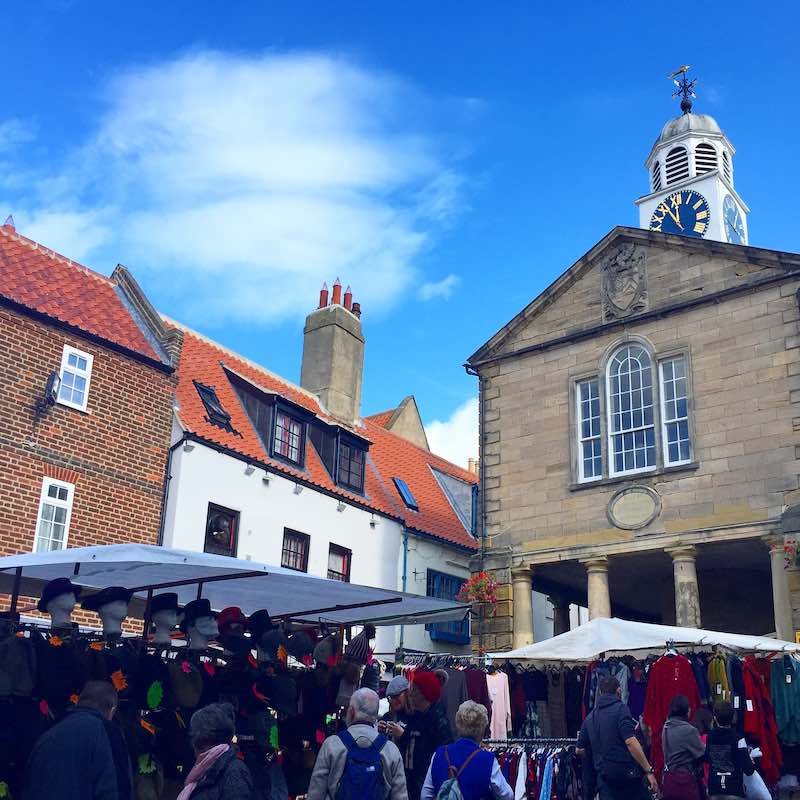When I get into the writing mood, its normally during or just after my holiday. It’s somewhat unusual for me to write about past travels when I’m not currently out there travelling or in the air (or recently returned from it). This post is somewhat different in that isn’t even about one of my most recent trips. I’m currently reading a book about destinations around the shipping forecast which triggered the idea of writing about the town of Whitby in North Yorkshire.
I’m not British, not a seafarer and not in my sixties, so before I get started on Whitby, I feel I need to explain my interest in the shipping forecast. I only discovered the shipping forecast in the ‘Calm App’ (Goggle it) as a bedtime story to assist in relaxing and getting a good night sleep. The rhythmic and somewhat poetic nature of the shipping forecast broadcast was quite relaxing, so a cover featuring ‘a journey round the shipping forecast’ caught my eye while browsing the travel selection at the city library.
I enjoy books that talk about travel with some sort of purpose (rather than just say a Lonely Planet Guide to …). In my latest library pick, Charlie Connelly documents his travel around the destinations featured in the shipping forecast. The entertaining and fact filled read, ‘Attention all Shipping’ is where Whitby was brought front and centre to my mind again. I’ll admit that before reading the book, I didn’t really have a clue or interest on the origin or history of the shipping forecast but I enjoyed how he used it as an excuse to explore the regions.
So, lets get to Whitby where this story should probably have began. If we were in Whitby today and tuned into the MET office shipping forecast, it would read something like this (yes I went to BCC Radio 4 online and listened to the forecast for today) read as follows.
Tyne, Dogger. South 6, to Gale 8 varying southwest 5 to 7 later. Occasional Rain. Good, occasionally Moderate.
In short, that doesn’t sound like an overly pleasant day. I know that not because I can translate this rhythmic phrase, but because it features the words ‘gale’ and ‘rain’ in the same report. Those words together from a phrase that a traveller never wants to hear in the forecast for upcoming adventures. Fortunately for me, my travels in 2017 didn’t feature gales or occasional rain.
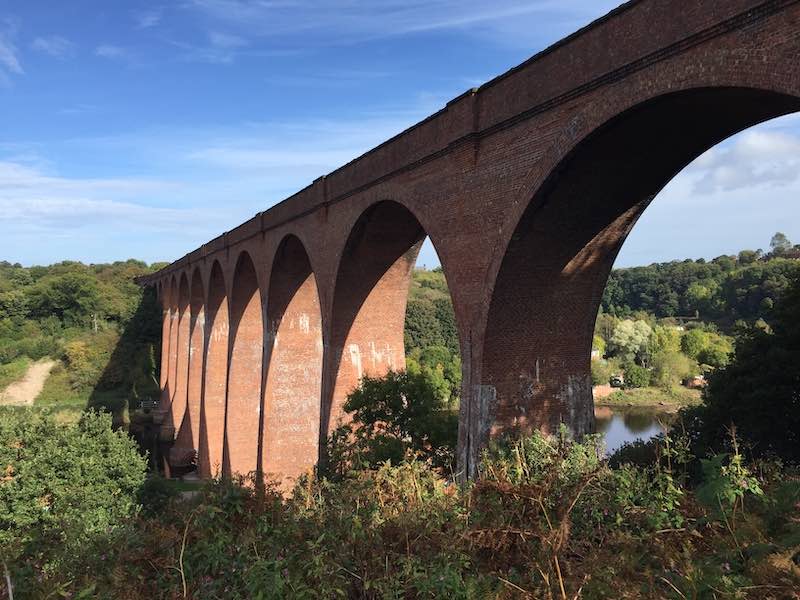
Our day trip to Whitby started from Leeds while visiting family during their year stay in the UK. Had it not been for visiting family, I doubt Leeds, nor Whitby would have been on my radar. One of the beauties about visiting family or friends or having a reason to go somewhere (other than just to holiday there) is that it takes you to places you may otherwise never go. It is also great as you get to tap their local knowledge to see the best parts of the area.
Having decided that the six of us were going for a day trip to Whitby, it was time to learn a little about Whitby. The only time I’d previously heard of the name Whitby was in ‘The Brittas Empire’, so presumed that we were off to visit the Whitby Newtown leisure centre. My preconceived ideas of Whitby were obviously framed with emotional receptionists with babies in drawers, badminton court murders, ridiculously detailed swimming registration forms, all coordinated with by a clueless, but well-meaning manager. If you’re lost, I suggest watching an episode of The Brittas Empire, it’ll make more sense. Alas, or should I say fortunately, Whitby was nothing of the sort.
Once we navigated the traffic of Leeds, we were on the ‘A roads’ around York (a beautiful city we would visit later in the trip) and through the North York Moors National Park. I’ll be honest in that I’ve never contemplated what a Moor was prior to writing this article. Fortunately for us, google and Wikipedia came to the rescue to inform me that its basically uncultivated hills or heaths (heaths are another landscape, not the late Heath Ledger). Whatever the terminology, the lands we passed were sparsely populated somewhat plateau like lands with low grasses and scrub intersected by winding gullies weaving across the landscape.
The main feature on the journey was the puffing smoke from a steam train chugging along the line towards Whitby (part of a weekend long Steam train festival). I’d later visit the railway museum in York, which has a great collection of historic trains, carriages and all things trains. If we had of planned, we probably could have taken one of the steam trains into town, but the convenience of the car was faster and gave us more flexibility than an old time train race through the history books.
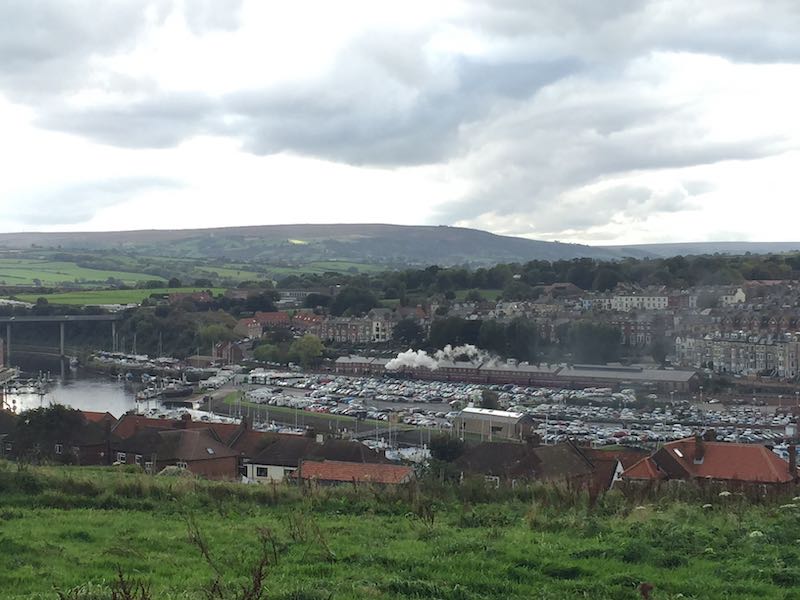
Local knowledge came in handy as we made a brief stop at the Larpool Viaduct on the outskirts of Whitby. Who doesn’t love a stop by an old railway line on the way to, well, anywhere really. While I’m an adult, the childish dream of living on a railway carriage never really left me. Originally built as part of the Scarborough and Whitby Railway it crosses the river Esk in spectacular fashion. Trains have been replaced by pedestrians and cyclists as part of a tourism cycle trail, however the best views of the bridge were had from the riverside holiday retreat at the base of the 13 arches that cross the river valley. A few photos and we were back on the road into Whitby proper.
Arriving into Whitby we parked at the Abbey parking lot along with every other day tripper into the city. As I’d later learn, everyone parks here not just for the great views of the abbey ruins, but also because there isn’t really anywhere closer to get to. Before we get to that, let me talk about the ruins before us. The abbey was disestablished (a fancy word for evicting the occupants) in the mid 1500’s when Henry the VIII decided it was time to shut up shop on a bit of religion in the lands. I’m no historian, but my brief reading on the topic sounds like a little bit of legal looting to top of the crown assets. Given Henry VIII was the head of the church in England at the time, I guess he felt that the money in monasteries and abbeys would be better managed by the crown.
Henry VIII may well have been able to take the religion (and anything of value) out of the abbey, but the stone that once formed the centre of a medieval kingdom dating back to the 7th century remains. The ruins sit on the east cliffs and overlook Whitby and the North Sea. Now a national history site, the brilliantly green lawns contrast against the blue sky with the sea in the distance beyond. A visitor centre provides audio guides with your entry fee that provide some history as we, in the words of the centre, took ‘a walk through history’. On the far side of the ruins a visitor centre provides exhibitions on the ruins and a café before spitting you out to the relatively new Church of St Mary (12th Century) and the top of the 199 Steps of Whitby.
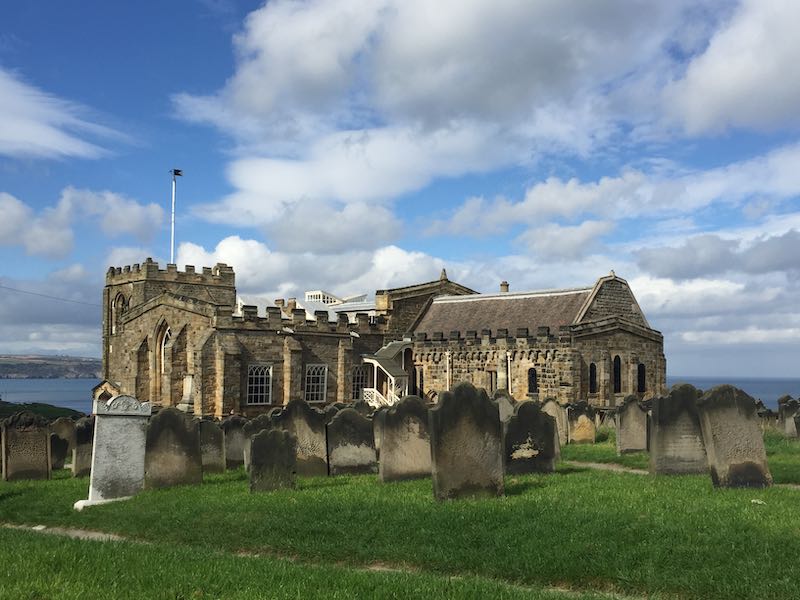
At first, I thought these steps were simply a practical way going up the hill that separates the town of Whitby and the Abbey on the hill. Steps frequently provide a method for going up hills. According to the local tourism office, the 199 Steps are however an attraction in themselves. The 199 steps are described as an ‘extraordinary attraction’ for ‘visitors who make the phenomenally tiring trek from bottom to top’. Now granted we walked down them first, but given our car was parked at the top, it was a case of what goes down must come back up again. Did I feel the burn in my legs on the walk up? Yes. Did I probably puff a little and use a handrail when available? Yes. Were people double my age taking it in their stride? Yes. Was it phenomenally tiring? No. It was however quite scenic.
The view from the top (from the cemetery surrounding St Mary’s Church) is a great starting place with its gothic cemetery providing an eerie starting point (or reward for those coming up). As we descended through the 199 steps (no I didn’t count them, although they recommend that the number one reason to do the steps is to count them) the narrow streets of Whitby that hug the shoreline of the harbour town do provide a lovely view. On the opposite side of the river lies a statue of Cook (more on him later) and the fishing harbour that once formed the heart of industry in the town.
The few open grass areas, complete with horses grazing disappeared as we entered Whitby proper. Everything is angled downhill and towards the river as we follow the narrow streets of Whitby. Each street is filled with stores selling every hand cum homemade tourist-attracting thing you would regularly find in such a seaside town. Intertwined with these knick-knack stores are several cafes and pubs bearing nautical or royal sounding names like the Duke of York or the Jolly Sailors Inn. After surviving the phenomenally tiring downhill slug, it was time to find some lunch and the Dolphin provide a prime riverside view.
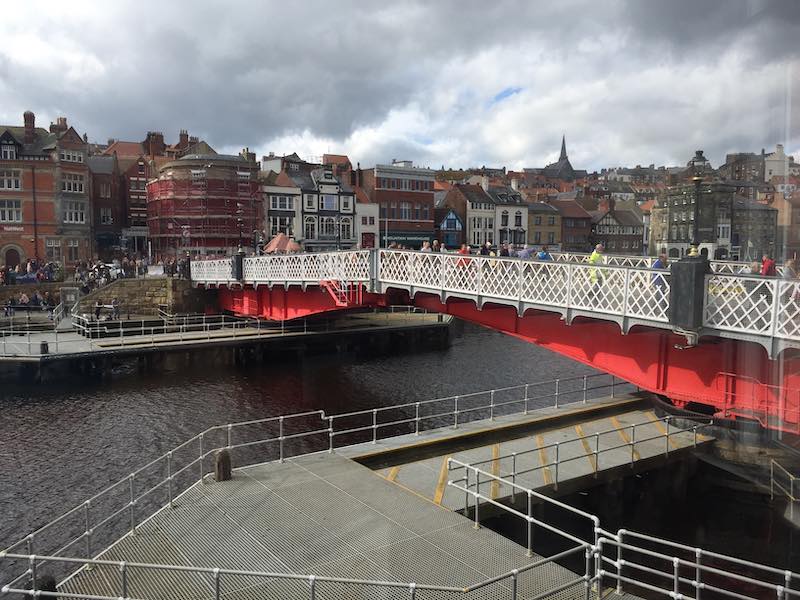
I’m not a foodie by any means, and to be honest I can’t remember whether the Dolphin served good or bad food, it was just food. It does however have a great view over the River Esk (the same that we saw the viaduct bridge cross earlier in the day) and the swing bridge. Originally named, Whitby Bridge is a swing bridge that, as its name suggests, swings open to let taller boats pass. Built around 1908 it allowed for taller ships to be built upstream and sail out to the North Sea. Whether or not ship building is still a thing in Whitby, I can’t answer, but the crowds of visitors love to watch it swing. Prime viewing position is from the windows of the Dolphin Hotel.
I also got to do something I wasn’t expecting at the Dolphin; teaching the bar staff how to make a drink. After a few weeks travel, I was craving a lemon lime and bitters. I know it’s a very Aussie drink to request but having spotted the bottle of bitters behind the bar, I thought I’d try my luck. The barman had no idea what I was talking about (the accent maybe didn’t help) but when I explained the ingredients he said he didn’t have any bitters (in a Yorkshire accent of course). When I pointed it out, he was surprised, saying he wondered what that was there for. In my mind, some Aussie moved to Whitby and donated it to the Dolphin after craving this sweet soft drink. So if you’re an Aussie travelling in Whitby, see if that bottle of bitters is still behind the bar.
Legs rested from the downhill decent, bellies satisfied with the Dolphin’s non memorable meals and full swing of the bridge observed it was time to explore the nautical history of Whitby. While the history of Whitby is definitely embedded in the sea, you’d be forgiven for forgetting this as you walk past the endless amusement arcades across the riverbank. The sea theme does come in with the northern bank of the river filled with whale watching and scenic cruise vessels waiting to catch their next load of visitors. The next catch would be us as we took a small vessel on a cruise out of the river mouth and into the North Sea.

This article started with a discussion about the shipping forecast, and while my visit was before I was aware of the relaxing tones of the forecast, I did think of the north sea as a rough beast not to be reckoned with. Rough seas, waves smashing across bows, dramatic rescues from stranded vessels, lighthouses watching helplessly as ships sank offshore; that’s what I pictured the north sea to be. If we had of been on the cruise today, where the shipping forecast is ‘Gale 8’, maybe it would have been. But for our cruise the waters were flat like a mirror. I don’t think I’ve every sailed on open waters so beautifully still. This was just as well, given I get notoriously seasick (and our vessel was about 2 people wide).
Cook’s statue watching from the head above we cruised through the safety of the harbour, past the small light house and into the calm waters of the North Sea. The next landfall (should we keep heading straight) would be the Norwegian coast, but fortunately after a few minutes we turned around and headed back to take in the view of the Abbey from the sea. Despite being closed by Henry VIII, the Abbey has been a landmark for passing sailors for centuries and was waiting to welcome us back into the harbour after our brief expedition into the seas.
Our short jaunt on the high seas was brief compared to a sailor who’d become a household name that started his sea life in this port. James Cook stared his sea bound career with a local shipping firm in Whitby before joining the navy and expanding the colonial empire across the globe. His statue sits overlooking the harbour and there is a museum dedicated to his life and sailing career. Having grown up learning of the first fleet and the founding of colonial Australia we gave the museum a miss, but it was interesting to see where the story began.
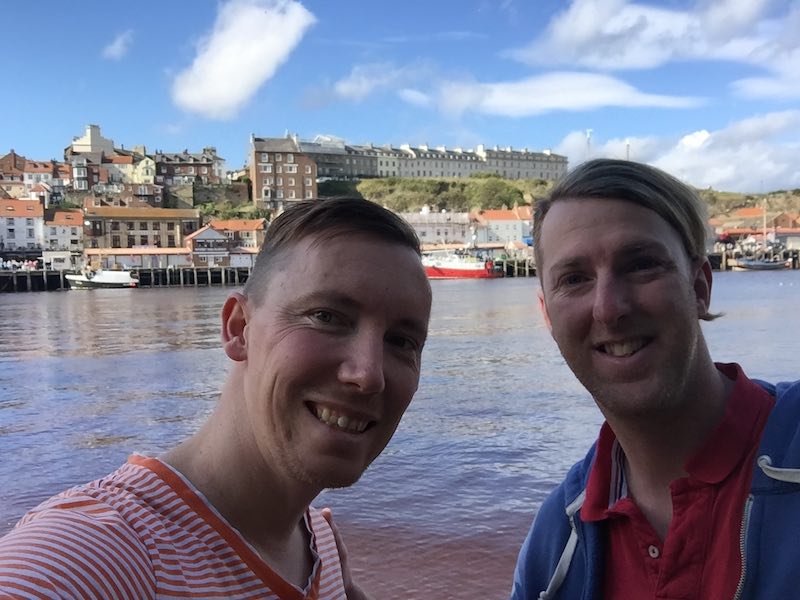
After making landfall after our maiden voyage we followed in the steps of many sailors before us and looked for some entertainment. Unlike the seamen of years past who would probably found the nearest brothel, we found some more family oriented entertainment (which wise given two of our party were under 5). The penny arcades that we past earlier were a heap of fun. Who know throwing money into a machine in the hope it will tip the balance and result in a windfall could be so entertaining. We ‘won’ a fair bit of loose change to make our few pounds of coins last a long time on the various games in the plaza before everyone started to get a little tired, it was time to start heading home.
I might have mocked the 199 steps attraction on the way into down, but after a day exploring Whitby each of the 199 steps were a good workout to end the day. The downhill walk into Whitby was a distant memory as we climbed uphill out of the town to begin our journey home. Naturally, I stopped to take a few photos (and my breath) on the return to the carpark before we finished up our time in Whitby where it began beside the abbey ruins. This article was a walk down memory lane and surprised me how a few photos can bring back a memorable and enjoyable day out with family. As I finish the article I wonder what stories I’ll read in the future that trigger travel memories of my own.
